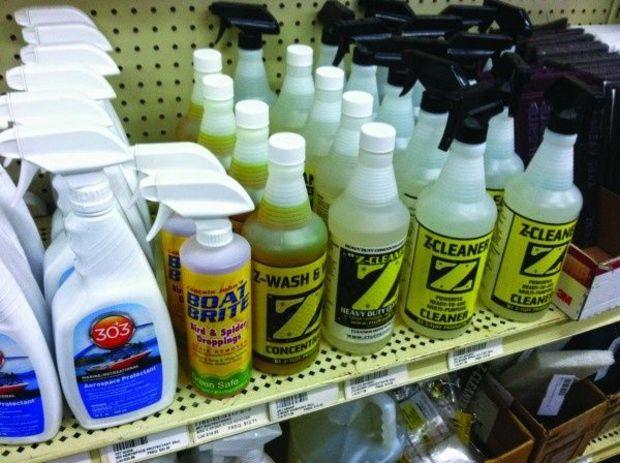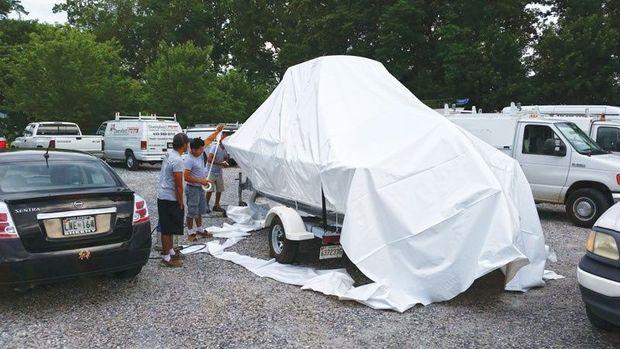
It’s mid-November as this issue of PropTalk gets distributed around the Chesapeake Bay, which means you’re pushing the envelope weather-wise if you have not winterized your boat yet. Here are some considerations as you get to work:
Antifreeze
By early November, the pink stuff all boat owners sought was already on sale at Fawcett Boat Supply in Annapolis. That included -50-degree (no need to dilute) and -100-degree (can be diluted) for drinking water systems and 2000 for engine systems.
Cleaning supplies
Some people think it’s a waste of time to clean their boats before winterization, but a lot of weather and moisture may touch your boat in between now and April. Clean her now, and you’ll stave off dirt and corrosion as well as save yourself time come spring. Bob Estes at Fawcett recommends a general purpose cleaner, such as Boat Zoap or Spray Away.
If you’d like to use a more environmentally friendly option, try Thetford Marine Boat Wash, Shurhold’s Yacht Brite Wash, or anything with the EPA’s Design for the Environment (DfE) Safer Choice label. Or, you can take the cheap, easy, and green route and use vinegar and water! Make a little baking soda and water paste to scrub out fiberglass stains.
Remove and store
You’ll want to remove cushions and clean them well. Some boaters like to store them elsewhere, preferably somewhere dry, for the winter—but if you do keep them on the boat, prop them up on edge to allow air to circulate.
Other items to get off the boat for safe winter storage: lifejackets, dock lines, fire extinguishers, flares, fenders, ski ropes, and the rest of your gear. To protect against damage and theft, remove GPS/chart plotters, radar displays, VHF radios, and other mounted electronics. Wrap the loose cable ends/connectors in electrical tape. Remove marine batteries and store them in a cool, dry location on a shelf.
Dehumidifier
You may spend as little as $5 to $15 on a moisture absorbing product (in basket or hanging bag form), which helps fend off mold and mildew. It will be money well spent.
Ventilation
Another thought on fighting winter mold: our friend at Fawcett also recommended good ventilation for your boat cover. “For both air in and air out,” says Estes. “That’s true all year long.”
De-icers
De-icers circulate water to prevent and melt ice around boats that remain in the water. You hang them from the vessel or dock. “When there’s a cold snap, everyone comes in to buy these, so we run out,” says Estes. Better to plan ahead. A Kasco De-Icer, with a thermostat control unit, costs $740.
 Shrink wrap
Shrink wrap
When you walk into a marina and see a lot of boats covered in white—shrink wrap, not yet snow—you know winter is on its way. Many regional marine service companies, such as Diversified Marine Services in Annapolis, offer professional shrink wrapping for boats. Those who are new to the process may think, “Wait! Won’t that trap moisture?” A good shrink wrapper will consider ventilation and moisture prevention and work it into the plan. Friends of PropTalk who have tried it have found it more economical than they had thought, as well as more effective. Shrink wrapping works both for boats stored on the hard and in the water.
Find more tips and resources at
proptalk.com/winterize.
 It’s mid-November as this issue of PropTalk gets distributed around the Chesapeake Bay, which means you’re pushing the envelope weather-wise if you have not winterized your boat yet. Here are some considerations as you get to work:
Antifreeze
By early November, the pink stuff all boat owners sought was already on sale at Fawcett Boat Supply in Annapolis. That included -50-degree (no need to dilute) and -100-degree (can be diluted) for drinking water systems and 2000 for engine systems.
Cleaning supplies
Some people think it’s a waste of time to clean their boats before winterization, but a lot of weather and moisture may touch your boat in between now and April. Clean her now, and you’ll stave off dirt and corrosion as well as save yourself time come spring. Bob Estes at Fawcett recommends a general purpose cleaner, such as Boat Zoap or Spray Away.
If you’d like to use a more environmentally friendly option, try Thetford Marine Boat Wash, Shurhold’s Yacht Brite Wash, or anything with the EPA’s Design for the Environment (DfE) Safer Choice label. Or, you can take the cheap, easy, and green route and use vinegar and water! Make a little baking soda and water paste to scrub out fiberglass stains.
Remove and store
You’ll want to remove cushions and clean them well. Some boaters like to store them elsewhere, preferably somewhere dry, for the winter—but if you do keep them on the boat, prop them up on edge to allow air to circulate.
Other items to get off the boat for safe winter storage: lifejackets, dock lines, fire extinguishers, flares, fenders, ski ropes, and the rest of your gear. To protect against damage and theft, remove GPS/chart plotters, radar displays, VHF radios, and other mounted electronics. Wrap the loose cable ends/connectors in electrical tape. Remove marine batteries and store them in a cool, dry location on a shelf.
Dehumidifier
You may spend as little as $5 to $15 on a moisture absorbing product (in basket or hanging bag form), which helps fend off mold and mildew. It will be money well spent.
Ventilation
Another thought on fighting winter mold: our friend at Fawcett also recommended good ventilation for your boat cover. “For both air in and air out,” says Estes. “That’s true all year long.”
De-icers
De-icers circulate water to prevent and melt ice around boats that remain in the water. You hang them from the vessel or dock. “When there’s a cold snap, everyone comes in to buy these, so we run out,” says Estes. Better to plan ahead. A Kasco De-Icer, with a thermostat control unit, costs $740.
It’s mid-November as this issue of PropTalk gets distributed around the Chesapeake Bay, which means you’re pushing the envelope weather-wise if you have not winterized your boat yet. Here are some considerations as you get to work:
Antifreeze
By early November, the pink stuff all boat owners sought was already on sale at Fawcett Boat Supply in Annapolis. That included -50-degree (no need to dilute) and -100-degree (can be diluted) for drinking water systems and 2000 for engine systems.
Cleaning supplies
Some people think it’s a waste of time to clean their boats before winterization, but a lot of weather and moisture may touch your boat in between now and April. Clean her now, and you’ll stave off dirt and corrosion as well as save yourself time come spring. Bob Estes at Fawcett recommends a general purpose cleaner, such as Boat Zoap or Spray Away.
If you’d like to use a more environmentally friendly option, try Thetford Marine Boat Wash, Shurhold’s Yacht Brite Wash, or anything with the EPA’s Design for the Environment (DfE) Safer Choice label. Or, you can take the cheap, easy, and green route and use vinegar and water! Make a little baking soda and water paste to scrub out fiberglass stains.
Remove and store
You’ll want to remove cushions and clean them well. Some boaters like to store them elsewhere, preferably somewhere dry, for the winter—but if you do keep them on the boat, prop them up on edge to allow air to circulate.
Other items to get off the boat for safe winter storage: lifejackets, dock lines, fire extinguishers, flares, fenders, ski ropes, and the rest of your gear. To protect against damage and theft, remove GPS/chart plotters, radar displays, VHF radios, and other mounted electronics. Wrap the loose cable ends/connectors in electrical tape. Remove marine batteries and store them in a cool, dry location on a shelf.
Dehumidifier
You may spend as little as $5 to $15 on a moisture absorbing product (in basket or hanging bag form), which helps fend off mold and mildew. It will be money well spent.
Ventilation
Another thought on fighting winter mold: our friend at Fawcett also recommended good ventilation for your boat cover. “For both air in and air out,” says Estes. “That’s true all year long.”
De-icers
De-icers circulate water to prevent and melt ice around boats that remain in the water. You hang them from the vessel or dock. “When there’s a cold snap, everyone comes in to buy these, so we run out,” says Estes. Better to plan ahead. A Kasco De-Icer, with a thermostat control unit, costs $740.
 Shrink wrap
When you walk into a marina and see a lot of boats covered in white—shrink wrap, not yet snow—you know winter is on its way. Many regional marine service companies, such as Diversified Marine Services in Annapolis, offer professional shrink wrapping for boats. Those who are new to the process may think, “Wait! Won’t that trap moisture?” A good shrink wrapper will consider ventilation and moisture prevention and work it into the plan. Friends of PropTalk who have tried it have found it more economical than they had thought, as well as more effective. Shrink wrapping works both for boats stored on the hard and in the water.
Find more tips and resources at proptalk.com/winterize.
Shrink wrap
When you walk into a marina and see a lot of boats covered in white—shrink wrap, not yet snow—you know winter is on its way. Many regional marine service companies, such as Diversified Marine Services in Annapolis, offer professional shrink wrapping for boats. Those who are new to the process may think, “Wait! Won’t that trap moisture?” A good shrink wrapper will consider ventilation and moisture prevention and work it into the plan. Friends of PropTalk who have tried it have found it more economical than they had thought, as well as more effective. Shrink wrapping works both for boats stored on the hard and in the water.
Find more tips and resources at proptalk.com/winterize.